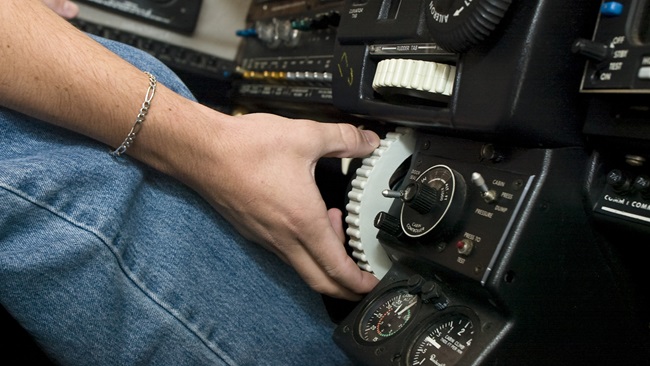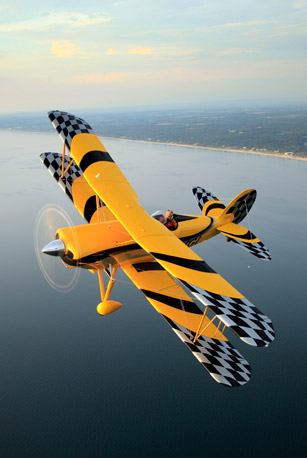
It happens at 125 miles per hour. That’s the speed at which the sound of the rushing wind drowns out the growl of the Great Lakes 2T-1A-2 Sport Trainer’s 180-horsepower engine. Conveniently, it’s also the recommended entry speed for loops and other over-the-top maneuvers, so the change in sound signals it’s time to pull.
Firm back pressure on the stick brings three positive Gs that quickly lift the nose up through the horizon and towards the fair-weather cumulus clouds far overhead. Glance left and right at the checkerboard wing tips for alignment, then relax the back pressure and wait for the moment that open-cockpit fliers fondly anticipate: floating weightless at the top of a loop while gazing upward at the Earth.
Fittingly, this sublime experience takes place over Lake Michigan in a Great Lakes by Waco biplane, the first new 2T-1A-2 Sport Trainer ever produced at the factory in nearby Battle Creek—and the first new production aircraft of its kind to take to the skies in almost 30 years. Placid air over the cool water and the golden glow of a summer evening provide ideal conditions in which to evaluate this special airplane, and to appreciate its subtle changes.
Its external dimensions, Lycoming IO-360 engine, and Hartzell constant-speed prop are the same as its predecessors, but differences in the new and old airplanes are more than skin deep.
the first great lakes biplane was built in Cleveland, Ohio, in 1929, with an 85-horsepower engine, and the company produced an ever-more-powerful series of one- and two-seat aircraft before going bankrupt in 1933 during the Great Depression.
A series of owners tried to revive and expand the biplane line with varying degrees of success. During the 1970s and 1980s, Great Lakes biplanes were offered in kit form, and Great Lakes produced the FAA-certified Sport Trainer with a 180-horsepower engine and a constant-speed prop.
The Sport Trainer accomplished the rare feat of having both delightful hand-ling qualities that individual owners and biplane connoisseurs enjoy as well as the robust construction and sturdy landing gear that could withstand punishment from new aerobatic and tailwheel students. About 150 Sport Trainers had been made when the company ceased production in 1985, and the tooling was packed away in a shipping container and parked in a field in northern Wisconsin, where it remained untouched for years. The jigs and fixtures might have stayed there forever, but two years ago Peter Bowers, president of Waco Classic Aircraft, went looking to expand his company’s offerings beyond the top-end, radial-engine YMF—and the Sport Trainer seemed like it could be a good complement.
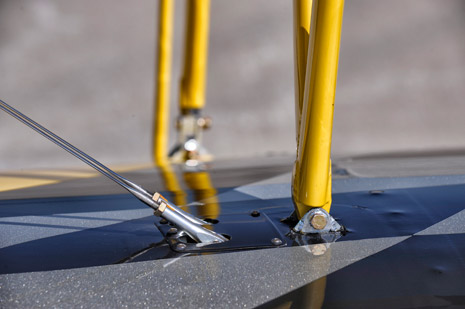
“We’ve developed the skill and expertise to produce tube-and-fabric airplanes of exceptional quality, and the Great Lakes looked like a perfect fit,” Bowers said. “The manufacturing processes are much the same, and we recognized areas where we could modernize and improve for the Great Lakes. The Great Lakes is a smaller, simpler airplane with a lower fuel burn and a lower price point, and it’s a very appealing airplane.”
Best of all, the Great Lakes had an existing type certificate, and the craftsmen at Waco Classic could build it alongside the YMF production line at their existing facility in Battle Creek. Bowers and John Duncan, owner of the Great Lakes type certificate, made an agreement in mid-2011 to restart production of the Sport Trainer as Great Lakes by Waco, and Bowers began marketing the new aircraft last year.
“We took deposits on 10 aircraft,” he said, “and that was extremely encouraging because it showed there’s a demand for the airplane.”
Bowers and his team surveyed owners and visited Chandler Air Service in Arizona, which operates a flight school that includes four Sport Trainers.
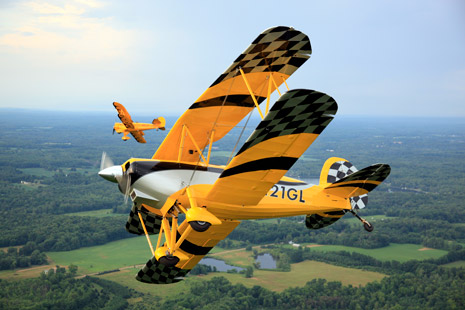
“We had extensive talks with the mechanics and pilots about all the things they liked and didn’t like about the original design,” Bowers said. “We came back with a long list of things we could do to improve it.”
The changes include:
- Reclining the pilot’s seat four inches to
improve cockpit comfort. - Adding toe brakes (instead of heel brakes)
to the rear cockpit. - Metalizing the fuselage from the firewall to the back of the rear cockpit.
- Changing the landing gear seals to prevent hydraulic leaks.
- Making the front and back windscreens taller for greater wind protection.
- Splitting the nose bowl to allow engine maintenance without removing the prop.
- Adding a substantial heater for cold-weather flying.
- Beefing up the horizontal stabilizer spars.
- Enlarging the oil cooler.
- Adding LED lights.
- Dramatically simplifying the panel, with remote Trig radios and transponders and a JP Instruments 930 engine analyzer.
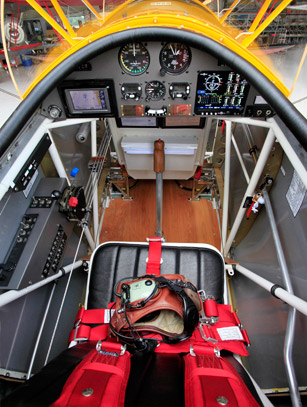
New production airplanes are expected to have empty weights of about 1,300 pounds. That allows for two adults as well as full fuel (27.4 gallons) while staying under the max gross weight of 1,800 pounds.
Stepping into the Great Lakes rear cockpit is a slightly delicate affair. With your left foot on a mid-fuselage peg and your left hand on a top-wing handhold, you step onto the seat and lower yourself into what feels like a rabbit hole.
Once inside, however, the cockpit is surprisingly roomy and the slightly reclined seat and pillow-like headrest are amazingly comfortable. Strapped into the Hooker five-point harness, everything seems exactly in place. The stick feels like an aluminum baseball bat, and its wooden handgrip, substantial throttle quadrant, metal side panels, and industrial electrical switches accentuate a sense of strength and bigness.
A Stearman is big on the outside and small inside. The Great Lakes is the reverse: small outside and roomy inside.
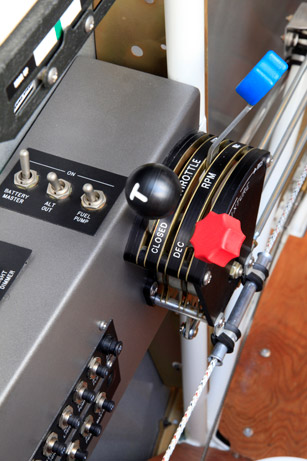
The Great Lakes instrument panel is the same slim size as the original. But with modern all-in-one instruments such as the JP Instruments 930 engine analyzer and remote Trig radio and transponder, the presentation is much cleaner and more appealing. Better yet, there’s a great deal more information with a Garmin Aera 560 displaying weather, TIS traffic, and a moving map; and the engine analyzer provides a clear display with an exceptionally accurate fuel computer.
Startup is normal for a fuel-injected Lycoming, and engine run-up is normal.The Alaskan Bushwheels steerable tailwheel is firm and positive during taxi. The Great Lakes sits at a fairly flat deck angle and forward visibility, while better than other biplanes, is still limited. S-turns are required for taxi to clear the area ahead.
Cleared for takeoff, the Great Lakes accelerates smoothly and energetically with the two-blade metal Hartzell prop turning 2,700 rpm. Holding a tailwheel-low attitude, the biplane’s main wheels come off the ground at about 55 miles an hour and the airplane quickly accelerates to 80 mph in a 10-degree climb.
Climbing at 25 inches MP and 2,500 rpm, the airplane instills in its pilot a disarming sense of relaxation and contentedness. Usually, an initial flight in a new airplane brings an edgy, pins-and-needles excitement. But the refinement, quality, stability, and obedience of the Great Lakes inspire confidence.
The fun meter picks up a notch when the maneuvering starts. Lazy eights, chandelles, steep turns, barrel rolls and loops are delightful—and the magic of the open cockpit enhances the pure joy of the experience. Full-deflection aileron rolls produce a roll rate of about 100 degrees per second. The stick has a wide area of travel, so the pilot must lean in to get full deflection.
Sustained inverted flight requires significant forward stick and an estimated 5-degree nose-up attitude to avoid descending. Negative Gs in an open-cockpit airplane are an acquired taste, and I only hang from the straps about five seconds, even though the header tank allows more than two minutes of inverted flight.
Unaccelerated stalls are benign at 57 mph, and you can almost see the stall progress as interrupted airflow buffets the fabric from wing roots to tips as angle of attack increases. There’s no stall warning horn, but the sights, sounds, and sensations of an approaching stall are obvious.
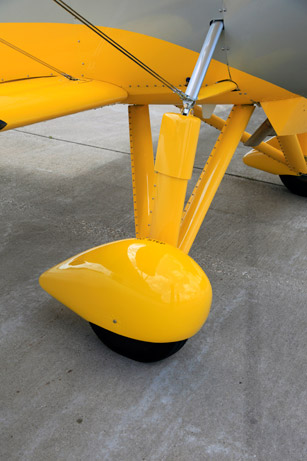
Elevator trim adjustments are made by pulling (or pushing) a cord below the throttle quadrant that runs all the way from the front cockpit to the tail. The trim mechanism seems oddly primitive at first, but it’s a clever and highly effective system that does away with the weight and complexity of an actual trim wheel.
Returning to Battle Creek, a power-off approach with a 180-degree turn to final at 75 mph produces a descent rate of about 800 fpm. Opening the throttle slightly on short final slows the descent rate to a more manageable 500 fpm, and increasing back pressure in ground effect slows the airplane to 62 as the main wheels roll on.
The soft oleo struts gently absorb any bounce and mild taps on the rudder keep the airplane tracking straight without braking. The Great Lakes is extremely forgiving on the ground, much more so than any other biplane I’ve ever flown.
My only nits with this first Great Lakes by Waco were a trace of friction in the ailerons, and the five-point aerobatic harness’s ratcheting mechanism was awkwardly placed. Those are easy items to address.
How the airplane does in the marketplace is an open question. It doesn’t directly compete with hard-core aerobatic biplanes like the Pitts S–2 series; and it’s not a vintage biplane such as a Stearman, Waco, or Bucker. Like other factory-new aircraft, the Great Lakes’ most formidable rival is likely to come from the existing fleet, in this case 2T-1A-2s made in the 1970s and early 1980s. But this, too, is opportunity because even the youngest Sport Trainer is nearly 30 years old—and there’s bound to be much interest among owners in modifying and upgrading their legacy aircraft.
In sum, the new Great Lakes exudes quality, craftsmanship, thoughtful refinements, and vigor. It’s a pleasure to behold, a joy to fly, and it’s sure to be an object of great affection for those fortunate enough to own, fly, or get a ride in one.
The speed, rate of climb, and other metrics are virtually unchanged from the existing fleet, and that too is by design. This is the continuation of an existing model, not a new one. And describing any open-cockpit biplane by traditional measures of speed, range, and payload is like saying Marilyn Monroe was 5 feet 6 inches tall and weighed 130 pounds. It may be true, but it utterly misses her essential nature.
Open-cockpit biplanes are about tangible intangibles that defy quantification: stick-and-rudder sensations, a felt connection to aviation history, and sharing the joyful spirit of flying with friends.
By those standards, the Great Lakes by Waco is a classic in the making.
Email [email protected]
Spec Sheet
Price: $245,000
Seats | 2
Length | 20 ft 4 in
Wingspan | 26 ft 8 in
Height | 7 ft 4 in
Wing area | 187.6 sq ft
Airfoil | M-12
Empty weight | 1,230 lb
Max takeoff weight | 1,800 lb
Engine | Lycoming AEIO-360-B1G6, 180 hp
Propeller | Hartzell or MT Composite
G Limits | +5.40 to -4.00
Max speed | 133 knots (153 mph) at sea level
Cruise speed | 105 knots (120 mph) (max cruise)
Stall speed | 50 knots (57 mph)
Range | 260 nm
Service ceiling | 17,000 ft
Rate of climb | 1,400 ft/min
Wing loading | 9.59 lb/sq ft

